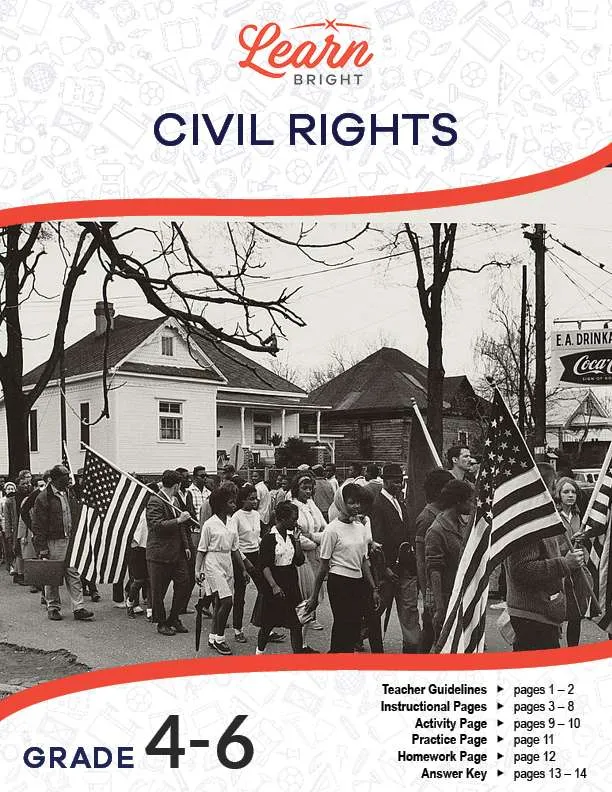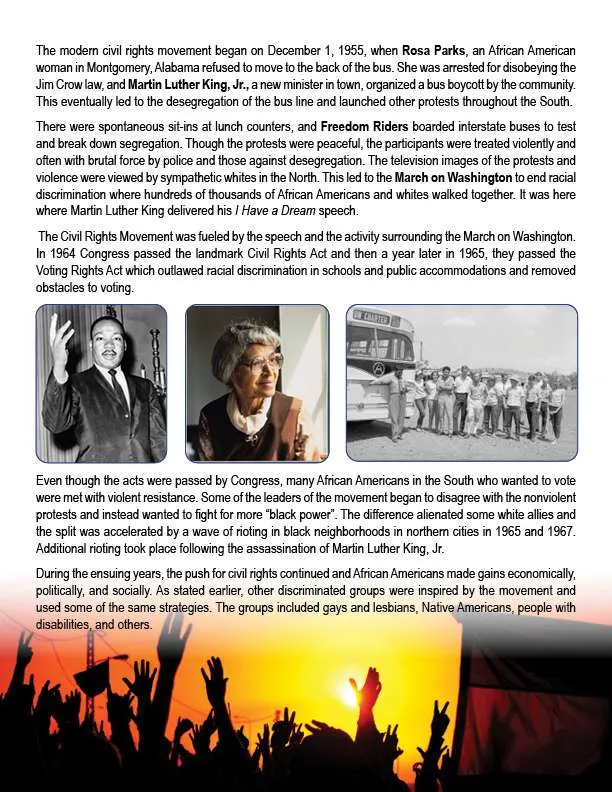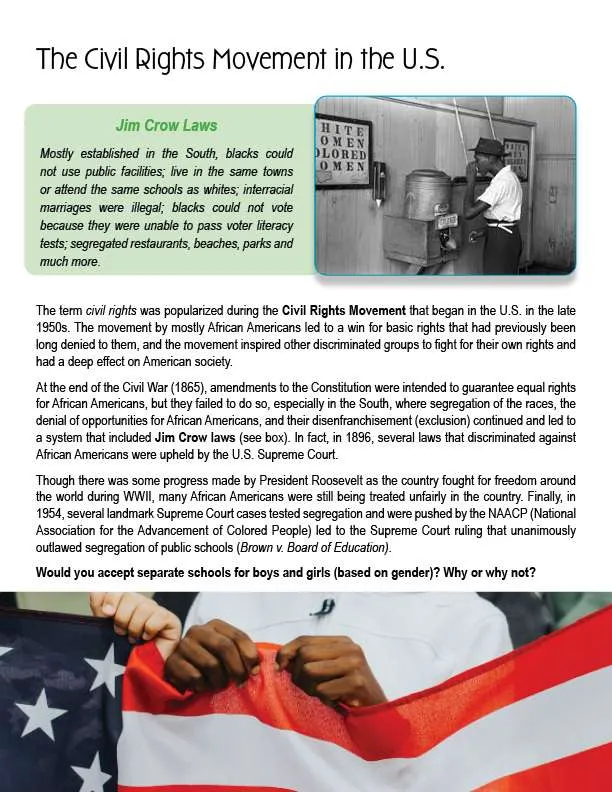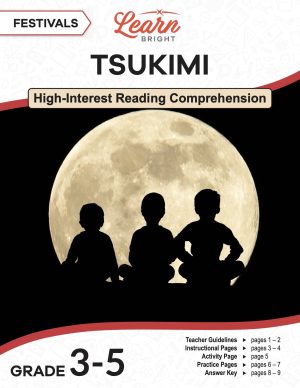Description
What our Civil Rights lesson plan includes
Lesson Objectives and Overview: Civil Rights teaches students about civil rights in the United States, including what the term means and some of the history of the Civil Rights Movement. At the end of the lesson, students will be able to define civil rights, describe major activities of the U.S. civil rights movement, and identify key civil rights leaders. This lesson is for students in 4th grade, 5th grade, and 6th grade.
Classroom Procedure
Every lesson plan provides you with a classroom procedure page that outlines a step-by-step guide to follow. You do not have to follow the guide exactly. The guide helps you organize the lesson and details when to hand out worksheets. It also lists information in the orange box that you might find useful. You will find the lesson objectives, state standards, and number of class sessions the lesson should take to complete in this area. In addition, it describes the supplies you will need as well as what and how you need to prepare beforehand. To prepare for this lesson ahead of time, you can create the groups for the activity and copy the handouts.
Options for Lesson
Included with this lesson is an “Options for Lesson” section that lists a number of suggestions for activities to add to the lesson or substitutions for the ones already in the lesson. One optional adjustment to the activity is to use the first part of the activity as a class discussion. Students can then complete the second part of the activity using poster paper, and you could display the posters in your classroom. For an additional activity, you could assign each student a different aspect, event, or person related to civil rights to research and present to the class. You could also invite a local civil rights activist to the class to speak with your students, and have them focus on how their group protests civil rights issues. Finally, you could invite people who have experienced discrimination to speak to your class about their experience.
Teacher Notes
The teacher notes page includes a paragraph with additional guidelines and things to think about as you begin to plan your lesson. It notes that you can teach this lesson at the same time as lessons about slavery, Martin Luther King Jr., Rosa Parks, the Underground Railroad, and more. This page also includes lines that you can use to add your own notes as you’re preparing for this lesson.
CIVIL RIGHTS LESSON PLAN CONTENT PAGES
What are Civil Rights?
The Civil Rights lesson plan includes six pages of content. Many people throughout the world use the term civil rights, but what does it mean? The word civil is part of the word civilian, so we can assume that it’s related to the rights of civilians or citizens of a country. The bigger question here is what are those rights?
The United States has a Bill of Rights which makes sure that its citizens have certain freedoms and rights. Over the course of history, some people have disagreed with what these civil rights are for certain people.
Wikipedia says that civil rights include ensuring peoples’ physical and mental integrity, life, and safety; protection from discrimination based on race, gender, sexual orientation, national origin, color, age, political affiliation, ethnicity, religion, or disability. Individual rights, which the Bill of Rights also outlines, include privacy and freedom of thought, speech, religion, press, assembly, and movement. You might want to think about whether or not you agree with this definition of civil rights and why or why not.
Civil Rights in the United States
In the United States, the government and individuals have violated the civil rights of some citizens, continuing on to today. They discriminated against African-Americans, for example, simply because of the color of their skin; women because of their gender; senior citizens because of their age; homosexual people because of their sexual orientation; politicians because of their political affiliation; and people with disabilities because of their disability.
People made decisions about many things based on other people’s race, gender, sexual orientation, national origin, color, age, political affiliation, ethnicity, religion, and disability. For example, if an African-American person lived in Alabama in 1955, they had to sit at the back of the bus because of the color of their skin, while a white person could sit wherever they wanted. In the 2000s, a bakery refused to make a wedding cake for a homosexual couple because of their sexual orientation, but would sell a cake to a heterosexual couple. In the first case, a public transit company discriminated against a category of people, and in the second, a private business. Should a private company respect the civil rights of all people?
Some people disagree on which civil rights we should protect. These disagreement have led to many problems in the United States and all over the world in the past, present, and likely in the future as well.
The Civil Rights Movement in the U.S.
Jim Crow Laws, mostly established in the South, prevented African-Americans from using public facilities; living in the same towns and attending the same schools as white people; marrying someone of another race; voting; and eating in segregated restaurants, enjoying beaches and parks, and more.
The Civil Rights Movement in the United States, which started in the late 1950s, helped popularized the term civil rights. This was a movement mostly by African-American people who fought for the basic rights that the government denied to them for many years. This movement inspired other discriminated groups to fight for their rights as well. It had a great effect on society in the United States.
After the Civil War, which ended in 1865, the government passed several amendments to the Constitution intended to secure equal rights for African-Americans. However, they failed, especially in the South. They enacted segregation, denied opportunities to African-Americans, and disenfranchised them in many other ways. This led to the Jim Crow laws. In 1896, the U.S. Supreme Court upheld several laws that discriminated against African-Americans.
President Roosevelt made some progress during World War II, but the U.S. still treated African-Americans unfairly. In 1954, multiple landmark Supreme Court cases tested segregation. The NAACP (National Association for the Advancement of Colored People) pushed these cases forward, leading to a Supreme Court ruling that outlawed the segregation of public schools (Brown v. Board of Education).
The Civil Rights Movement – 1955 and Beyond
The Civil Rights Movement really started on December 1, 1955, when African-American activist Rosa Parks refused to move to the back of the bus in Montgomery, Alabama. The police arrested her for disobeying the Jim Crow laws. Martin Luther King, Jr., a new minister in town, organized a bus boycott in the city. This led to the eventual desegregation of the bus line. It also led to other protests across the South.
People participated in spontaneous sit-ins at lunch counters. The Freedom Riders boarded interstate buses to test the limits of segregation and help break it down. They led peaceful protests, but the police and other people against desegregation responded with violence and brutal force. Sympathetic white people in the North saw images of the protests and violence in the North. This led to the March on Washington to end racial discrimination. Hundreds of thousands of African-American and white people walked together. Martin Luther King gave his famous I Have a Dream speech.
The Civil Rights Movement gained more momentum because of King’s speech and the activities around the March on Washington. in 1964, Congress passed the Civil Rights Act. In 1965, they also passed the Voting Rights Act, outlawing racial discrimination in schools and public accommodations and removing obstacles to voting.
Despite these new acts, people violently resisted some African-American people who went to vote in the South. Some leaders of the movement disagreed with the policy of nonviolence and wanted to fight back for Black power. Some white allies felt alienated by this shift. Neighborhoods in northern cities also saw riots in 1965 and 1967. After the assassination of Martin Luther King, Jr., more riots took place.
In the following years, African-Americans continued to push for civil rights. They made economic, political, and social gains. Other discriminated groups, like gays and lesbians, Native Americans, and people with disabilities, also used their methods to fight for their own rights.
Other Civil Rights Activities
Several important activities and events happened during the Civil Rights Movement and beyond. The lesson covers three of them. First, the Little Rock Nine refers to the desegregation of a public high school in Arkansas. In September 1957, nine Black students attempted to enter Central H.S. The Arkansas National Guard and a screaming mob met them at the school. As a result, President Eisenhower ordered federal troops to escort the students into the building and between classes.
Next, four college students led a sit-in at the Woolworth’s Lunch Counter in Greensboro, NC in February 1960. They refused to leave until someone served them. Hundreds of people joined them, some of whom the police arrested and charged with trespassing. This led to an organized boycott of lunch counters. The owners eventually relented, and this contributed to the founding of the Student Nonviolent Coordinating Committee.
Finally, Bloody Sunday happened on March 6, 1965. 600 people marched from Selma to Montgomery to protest the murder of an activist. The Alabama state police met them at a bridge in Selma and blocked them. The marchers refused to back down and the police violently beat and teargassed the crowd. They had to hospitalize many marchers.
Modern Civil Rights Movements
Some modern civil rights movements include LGBTQ employment and discrimination, as employers terminate employees based on their gender identity or sexual orientation; human trafficking of people forced to do labor or endure sexual exploitation; and the fight against police brutality, where police shoot and often kill unarmed people, mostly black men.
Some other movements include the fight against disability discrimination in the workplace and elsewhere, pregnancy discrimination, weight bias, religious bias, and making sure all students have fair education opportunities.
Civil rights include ensuring that people have secure physical and mental integrity, life, and safety; protecting people against discrimination on the grounds of race, gender, sexual orientation, national origin, color, age, political affiliation, ethnicity, religion, and disability.
Everyone is affected when someone’s civil rights are not respected and are violated. If someone violated one person’s rights, someone else will feel empowered to violate more people’s rights in the future. You and a friend might disrespect someone who is different from you. How would you feel if someone did the same to you in the future?
Key Terms
Here is a list of the vocabulary words students will learn in this lesson plan:
- Civil Rights: Ensure peoples’ physical and mental integrity, life, and safety
- Jim Crow laws: Established in the South, blacks could not use public facilities
- Rosa Parks: Refused to move to the back of the bus
- Martin Luther King Jr.: Minister who organized a bus boycott by the community
- Freedom Riders: Boarded interstate buses to test and break down segregation
- March on Washington: Hundreds of thousands of blacks and whites walked together
CIVIL RIGHTS LESSON PLAN WORKSHEETS
The Civil Rights lesson plan includes three worksheets: an activity worksheet, a practice worksheet, and a homework assignment. You can refer to the guide on the classroom procedure page to determine when to hand out each worksheet.
ACTIVISM ACTIVITY WORKSHEET
Students will work with a partner to complete the activity worksheet. Each pair will read and discuss questions about the Civil Rights Movement in the United States. They will write down their answers to each question. They do not have to agree with each other.
Next, each student will work on their own to choose one of the civil rights listed on the worksheet that all people have. They will create a slogan, motto, saying, rhyme, drawing, picture, or something else that they could use during a protest against the discrimination of the right.
MATCHING PRACTICE WORKSHEET
For the practice worksheet, students will match the statement, description, or definition to the correct term.
CIVIL RIGHTS HOMEWORK ASSIGNMENT
The homework assignment asks students to first read different scenarios and determine how each people most likely may have been discriminated against. They will then interview an adult family member, neighbor, or friend and ask three questions about discrimination and civil rights. They will write down their answers in the space provided on the worksheet.
Worksheet Answer Keys
This lesson plan includes answer keys for the practice worksheet and the homework assignment. If you choose to administer the lesson pages to your students via PDF, you will need to save a new file that omits these pages. Otherwise, you can simply print out the applicable pages and keep these as reference for yourself when grading assignments.









